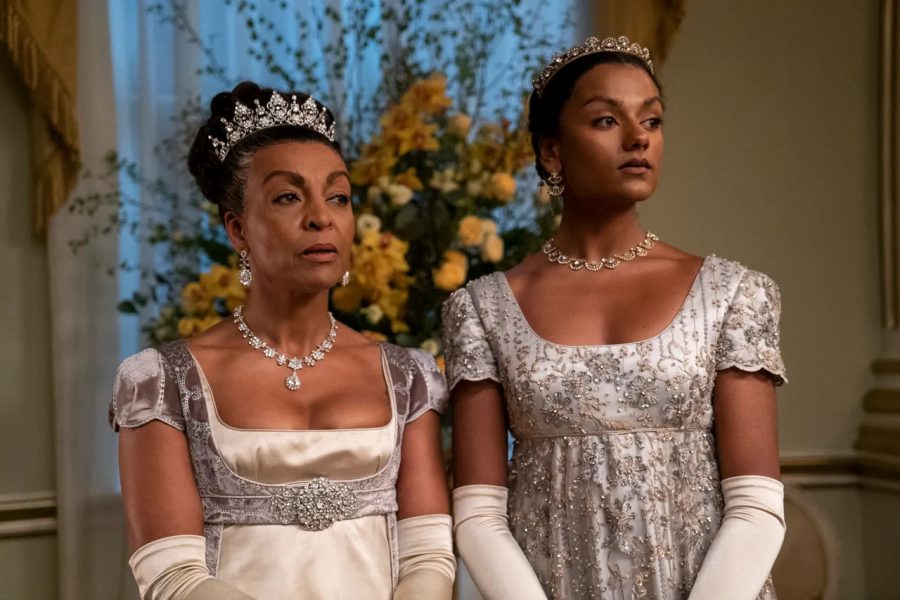The Irony of Painful Corsets in “Bridgerton”
Beneath the sweeping, bejeweled skirts of “Bridgerton” hides a dangerous, insidious thing, wrapping its arms around the ribs of young women and squeezing the air from their lungs: corsets. Recently, Simone Ashley, who plays Kate Sharma in season two of the Shonda-land hit, confessed to Glamour Magazine UK that, while wearing a corset, she found that she couldn’t eat properly. Other actresses, including Emma Stone, Dakota and Elle Fanning and, the period-drama queen herself, Kiera Knightely have all complained of similarly having to sacrifice their breathing, eating and moving for the noble goal of creating a historically accurate period drama. A similar echo haunts their complaints: Thank God we no longer wear such restrictive clothing; thank God women no longer change their bodies to fit into societal beauty standards. It prompts the question: Were corsets really that awful? If they were, how did women bear them for centuries?
The truth is, the modern perception of the corset is wrong. Yes, some forms of corsets could alter the body’s natural form, and some could cause pain. However, at the end of the day, corsets were structured underwear intended to distribute the weight of the female figure across the wearer’s body. Women had some more comfortable versions they would wear when relaxing at home or doing work, while more constricting ones were worn out to parties. It was akin to wearing a sports bra under your sweatshirt and a push-up bra under your party dress.
Corsets — or, as they were contemporaneously known, “stays” — remained prevalent in European society for about 400 years, having been invented in the Elizabethan era. In the Regency period of the early 19th century, which is when “Bridgerton” takes place, corsets had expanded into a handful of different versions. It’s the Victorian Era of the mid-19th century where the toxic notions of corsets originate.
Tight-lacing, which was when women would tighten their corsets to achieve a smaller waist, grew in prevalence in the Victorian period. When you watch the many film and television scenes of women holding onto the edge of a table, chair or bed while a sweating maid tightly pulls the laces of their corset, you are witnessing tight-lacing. A character from “Bridgerton,” Prudence Featherington, is shown as a victim of this process in one of the show’s early scenes. It’s a good visual metaphor for the oppression that women in Regency-era and Victorian-era England faced, but the commonality of the trope deludes many viewers into thinking this was the reality of wearing a corset.
However, this was rather uncommon. Rebecca Gibson, a student at American University, found that the material record does not support this, as the historical corsets she studied do not show the strain of constant tight-lacing. That does not mean it never happened, it just happened very infrequently.
Victorian corsets have also been found to deform the spines of women who wore them throughout their lives — which is, I’ll admit, terrifying — but Gibson’s work also found no evidence that these deformities lessened the woman’s quality of life. Some of these women even outlived their time’s average lifespan.
In an interview for Smithsonian Magazine, Hillary Davidson, a dress historian and author, scoffed at the idea that “women ‘walked around in these uncomfortable things that they couldn’t take off, because patriarchy … They put up with it for 400 years? Women are not that stupid.’”
However, if corsets were garments that regular women wore everyday with little to no issue, why do so many actresses have so many horrible experiences with them? If Simone Ashley, for example, had worn a historically accurate half-stay, the constricting fabric would not have even touched her stomach and restricted her eating. Davidson believes that it’s due to the “Corset Myth,” which has “fed off people trying an off-the-shelf-corset, lacing it too hard and fast, and creating pain.” In her experience, these afflictions are alleviated as soon as the garment is properly fitted.
The costume designer of “Bridgerton,” Ellen Mirojnick, shrugged off the discomfort of these costumes, saying, “Of course, a corset will never be truly comfortable.” And no, a corset is never going to be as comfortable as a sports bra, bralette or — best of all — no bra, but it shouldn’t cause so much pain that actresses complain about being able to eat properly or even breathe.
There’s truly something ironic about forcing modern women to endure physical pain in order to falsely portray the pain of historical women. It begs the question, why do we feel such pleasure at these women’s suffering?
We, as modern women, watch period dramas and inhale, our hands pressed against our rib cages to feel how much they swell free of the corset’s constriction. The modern, western woman has more rights than her 19th century counterpart, to be sure, but are we so certain that we’ve surpassed them in this? Liposuction is now the second-most popular cosmetic surgery in the United States, and around 16% of the recipients are under the age of 30. It’s fun to scoff and shudder as we watch shows like “Bridgerton,” where young women force themselves into corsets and struggle under a patriarchal society, and to imagine ourselves so much more evolved than them. The truth is that corsets were neither painful nor restrictive when made and worn correctly, and that modern women continue to alter our bodies for beauty standards. In that sense, the young women of “Bridgerton” are much more relatable than we might have originally thought.
Kari White, FCRH ’24, is an English major from Wilmington, Del.

Kari White is a senior from the blink-and-you’ll-miss-it state of Delaware. She is majoring in English with a concentration in creative writing, as well...










































































































































































































